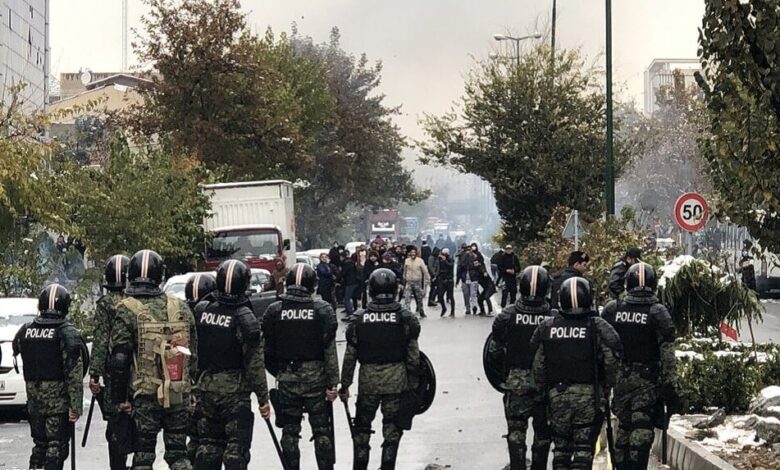Iran’s Autocrats Masquerading as Champions of Human Rights

iran-protests-security-forces-crackdown
Written by
Shahriar Kia
This week, a media outlet with close ties to the Iranian regime’s Islamic Revolutionary Guard Corps highlighted commentary from the regime’s so-called human rights monitor regarding campus protests in the United States over the war in Gaza. Tasnim News Agency quoted Kazem Gharibabadi, secretary general of the Iranian parliament’s High Council for Human Rights, as saying that differing responses to the unrest in the US and Iran are “proof of contradictions and double standards” by the United Nations, whose High Commissioner for Human Rights has issued “three statements accusing Iran of human rights violations” since nationwide protests broke out there in September 2022.
The start of those Iranian protests coincided with the funeral for Mahsa Amini, a 22-year-old Kurdish woman who was killed during a visit to Tehran when “morality police” determined that she was wearing her mandatory hijab too loosely, and violently arrested, leading to her losing consciousness at a reeducation center and dying three days later.
Following Amini’s death which sparked a nationwide uprising, Iranian authorities opened fire on crowds of protesters, often using live ammunition, and carried out mass arrests which led to torturous and sometimes fatal interrogations. According to an intelligence network associated with the country’s leading opposition group, the People’s Mojahedin Organization of Iran (PMOI/MEK), at least 750 people were killed outright during the uprising, and more than 30,000 others were arrested.
While sentences are still pending for thousands of those who were not released and for those who have lately been re-arrested, it has been reported that dozens of others have received death sentences, nine of which have been implemented so far.
Recalling Iran’s nationwide November 2019 protests after gas price hike
Moreover, in the wake of two significant United Nations resolutions—namely, the renewal of Javaid Rehman’s mandate as the UN Special Rapporteur on the human rights situation in Iran and the extension of the UN Fact-Finding Mission’s tenure for another year—the clerical regime has escalated its pace of executions. In the last 13 days, reports indicate at least 74 instances of state-sponsored killings across Iran.
The brutal crackdown coincides with an increased push for enforcement of the so-called “Islamic” dress code in Iran. The head of the regime’s State Security Forces, Ahmadreza Radan stated on April 25 that 32 separate agencies were involved in that push, which has yielded numerous videos and photographs, shared on social media, of women being harassed in the streets and violently arrested for both deliberate and incidental hijab violations, as part of a campaign called “Noor,” or “Light.”
The arrests are highly reminiscent of the coordinated crackdown on the 2022 uprising and thus raise concerns about the potential for permanently injurious or even fatal outcomes. Those concerns could be further amplified by a report from the BBC on Tuesday which detailed leaked documents from an IRGC internal inquiry into the widely reported death of one of the protesters of the 2022 uprising. The documents’ legitimacy was reportedly verified by multiple sources over a period of months, and they confirm that 16-year-old Nika Shakarami was indeed killed after being arrested at a protest, as was widely assumed by the activist community and her family.
Watch and judge how this official explains #Tehran’s #HumanRightsViolations in 20 seconds pic.twitter.com/GbNVC9WI6w
— NCRI-FAC (@iran_policy) January 16, 2024
In support of their cover story, the IRGC suppressed its inquiry into Shakarami’s death, which revealed that it had been caused by a three-person team affiliated with a separate paramilitary group sometimes employed for repressive activities by the Revolutionary Guards. Interviews with those involved portrayed the outcome as unintentional, with the three men having beaten her with batons after she fought back against molestation by one of them. Oddly, the individual in question did not even deny the molestation.
The report went on to state that an IRGC officer, upon learning that the occupant of the police van was dead, explicitly advised the team to “dump her in the street.” His decision was evidently informed by the fact that the IRGC headquarters was already dealing with the deaths of several other protesters and was by this time concerned with the relevant statistics. This suggests the existence of a broader cover-up and lends credence to the notion that the death toll from the 2022 uprising has been widely underreported.
Yet, while the clerical regime desperately endeavors to exploit events on American campuses, it fails to deceive the majority of Iran’s society, which endures the relentless oppression and brutality of the regime with every passing moment. On the opposite, the displayed level of hypocrisy only exacerbates the still open wounds of thousands whose loved ones have yet to see justice served.

